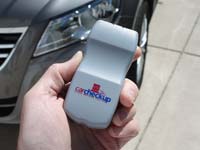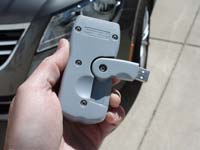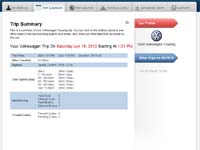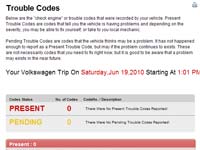The car Bibles product reviews: CarMD diagnostic tool.
Product Reviews
CarCheckup Automotive diagnostic tool
Tested June 2010 
Website: CarCheckup.com


The CarCheckup diagnostic tool is very similar to the CarMD (review) in that it's yet another device that can be plugged in to your vehicle's OBD2 port to diagnose various issues. What makes this device a little different is that it includes a datalogger - onboard memory that stores key values from your vehicle as you drive it for later analysis. The device itself is a little smaller than the CarMD, primarily because it's designed to be left plugged in to the vehicle whilst driving. It has a self-contained swing-out USB connector on the back which means you don't need any extra cables to connect it to your PC. When plugged in to the OBD2 port, the unit flashes a green LED on the back of it - this means it's in a 'ready' mode but not actually doing anything. When you start the car and the engine runs, the LED turns orange meaning it's now in 'data gathering' mode.

Despite the unit itself being fairly compact, it does naturally take up some space below the dash. In my current vehicle, it's not an issue - the photo to the right shows where the CarCheckup sits under my dash. In my previous vehicle, the OBD2 connector was placed right above the accelerator pedal so there's a possibility that an errant foot could catch the unit in that situation. There are SAE guidelines describing a 'clear area' that manufacturers should leave around the OBD2 port and the CarCheckup unit is designed to fit within that area. Even so, if you're thinking of getting one of these, best check the location of your OBD2 port first.
What's a datalogger?. A datalogger is a computer system that sucks data from an input as fast as it can and stores the data to be downloaded later. The CarCheckup has a datalogger in it, and the company says that one of it's key selling points is the ability to check up on your teen driver. So how does this work? First you need to plug the unit in to a free USB port on your PC. It will detect the new hardware an install a UART USB-to-serial driver automatically and then the green LED on the CarCheckup will start to flash.

Then you need to set up an account at CarCheckup.com. When creating the account for this test, the validation email took about 20 minutes to arrive, and once it did, I was able to login to the site. Once logged in, if you've never connected a device before, you can click the 'download data' button and the site will then interrogate your CarCheckup unit (as long as it's plugged in to your USB port), download all the stored data on it and then reset it for the next trip. One thing I found a little irritating was that you must use Internet Explorer for this data download to work because it requires an Active-X control to be installed. I'm a heavy Firefox and Safari user so it was disappointing that I was forced to use IE for this part of the operation.

Once the initial set of data has been uploaded to the site, you will be prompted to enter in your vehicle make, model and year. Another minor niggle for me here - their site did not have my model or model year of vehicle (a 2010 VW Tiguan) so I had to substitute a 2009 VW Tourag for the test. It makes no difference to the data - it's simply a way of tracking which vehicle is which, and you get one free vehicle tracking account with each CarCheckup unit. (I contacted their tech support about this and they seem happy to respond to items like missing vehicles so I suspect the Tiguan will be a valid vehicle choice shortly).
I was surprised that their site did not have reverse VIN lookup like the CarMD site does. This is where the device attached to the OBD2 port stores the vehicle's VIN and that is then used to automatically lookup the make and model. There are technical reasons why this might be the case - I know not all cars will report their VIN through the OBD2 port but the CarCheckup system can at least compensate for that by creating a unique 'fingerprint' of your vehicle's onboard systems to identify it correctly when hooked up to your online account.
The 'checking up' part


Once your data is uploaded to the site, it's available to view through your account at any point in the future, through any web browser, without the CarCheckup unit being attached to the USB any more. From the account page, pick a trip from the drop-down list showing all the trips by date and time and click 'view'. This brings up the trip profile screen which is a snapshot of data from the trip in question, with a breakdown of the total trip time and mileage as well as the amount of time spent in various speed bands (40-49mph, over 70mph etc.) This data is quite useful if you're interested in modifying your own driving behaviour as it gives you a good idea how long you spent idling, driving at certain speeds, and where the throttle was. Being more aware of these sorts of values gives you an unbiased glimpse into how you're actually driving.
Along the top of the trip profile screen there are also several tabs available - trip summary, trip graphs, trouble codes and advanced data. Trouble codes is where you go to look for any stored or pending error codes - the things that the engine management system uses to determine whether or not to turn on your 'check engine' light.
For the car nerd or concerned parent, the place you'll go first through is 'trip graphs'.

For me, this screen is both fascinating and contentious. I'm an adult with no kids, and a car nerd, so for me it's an interesting glimpse into how I drive my car. But that is exactly how this device can be used to 'spy' on your kids driving habits. I'm not going to get into the debate about whether or not you should trust your kids or spy on them - that's up to you. But the graphing screen can be quite revealing. For the test drive, I drove some city streets then headed out to a motorway on-ramp. I waited for a gap in traffic then floored it to see how the datalogger would respond. I then found another on-ramp and used it as I would normally. If you look at the resulting graphs on the left, it's very revealing. The section I've highlighted with the blue arrows shows the deliberate hard acceleration. You can see the RPMs rise quickly in-line with the increasing speed. Compare that to the second on-ramp highlighted by the orange arrows, showing a more sedate increase in RPM but the same increase in speed. The concerned parent could look at these graphs and determine that something 'interesting' went on where I've highlighted with the blue arrows. Was their young driver racing? Why the massive burst in acceleration and speed?
It's worth pointing out here that the tracking feature can also be pressed into service for other reasons. For example if you're a fleet manager and you want to see how your employees are treating their vehicles, this unit would help you out there. It's still spying, but in the case of adults who should know better, its potentially less contentious.
In addition to the basic speed and RPM graphs, the 'advanced' data tab allows you to download graphs or raw data for (amongst other things) speed, RPM, load value, coolant temperature, ignition timing, intake air temperature, air flow, and throttle position. For the example trip above, the raw throttle position data shows the throttle open at 92% corresponding with the acceleration burst and spike in speed. A surefire sign of 'spirited' driving.
Mileage tracking
Another feature of the CarCheckup system is that it allows you to categorise each trip. Business, commuting, leisure etc, and then you can create reports between any two dates listing which trips were categorised which way. If you run your own business, or have a fleet car, this is actually a great way of mileage tracking your business use, for example, along with date and time reports of each trip.
Conclusion : the datalogger is the value-added piece of this puzzle
The CarCheckup enters a market already populated with other similar 'check engine' devices. It doesn't have the three colour-coded LED ease-of-use factor that the CarMD does but the error code reporting is very similar, giving error codes along with a translation and explanation of what that code typically means. What helps the CarCheckup to compete in this marketplace is the datalogger. For business mileage, it's a great way to automatically report miles driven. For concerned parents, it's an impartial observer that has no bias and simply reports everything exactly as it was. It doesn't matter what the driver tells you they did, the datalogger will show you what they did. For the same reason, I can see this appealing to car nuts too - a self-contained datalogger that doesn't need a laptop strapped to the passenger seat and cables everywhere? Win-win.
So why 4 stars instead of 5 for the review? A couple of reasons. First, the need to use Internet Explorer to upload the data. It's a minor hassle but a small java app might have done the same thing and would make it friendly with more browsers. Second, the lack of reverse lookup using the vehicle's VIN to determine the make, model and year - even though I understand why that limitation exists. Third, the device form factor could interfere with your feet when driving in some vehicles. And finally the ethical questions this device raises about trusting your kids vs. spying/monitoring. I can see both sides of the argument and it's not my place to say which is right.
Altogether though, these are trivial concerns that I suspect won't worry 90% of the people looking at devices like this.
